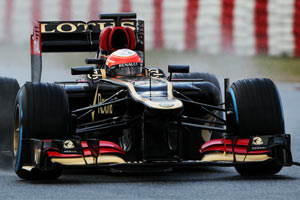There is more then one reason that leads me to think that the drd on the lotus (and merc as well) works by sucking instead than by blowing.
Given the slot position (both for this year and last year) is on the convex side of the wing lower surface, in order to detach the boundary layer you need to draw in air (thus pulling the stream line down, away from the surface) - if you blow air out of the duct, you are instead helping the flow stay attached.
If one looks at the situation in terms of angle of attack of the wing, it could be seen that sucking into the pipe from below increases the angle of attack, thus leading to stall, whereas blowing would reduce the angle of attack fo the wing section.
You do not need a massive flow to stall the main plane, just a small perturbation is enough.
The low sucked in does not interfere with the engine inlet; it just mixes with the flow in the main pipe of the device, that has its dedicated inlets (ears around airscoop) and outlet.
The big monkey seat is necessary to the system, not because of the downforce it generates, but because of the low pressure at its back. This is drag for the car, but it is necessary evil, since this low pressure gives the driving force to the air to get trough the pipe: this is a good indication of the presence of a bottleneck inside the pipe (a venturi if you like the jargon). You can not push air in a duct with a bottle neck and hope it will accelerate at the throat - you have to pull it from the end of the duct.
We can see how nicely lotus have evolved their system for this year: it does not need the monkey seat, it uses an extension of the engine cover instead. This is just a tilted monkey sit- it is horizontal, but since the flow impacting on this surface has downwash, its relative incidence to the flow is still enough to generate the needed low pressure ot drive the main pipe.
The main pipe is also shorter - to get advantage of the downwash and also to have lower friction losses - it is also lighter which does not hurt.
As I wrote above, you can tune the system by selecting different throat areas inside the main pipe, probably the fine tuning could be made also using wire meshes of different permeability.
If I think the system works this way, everything fits nicely for me; if I try to think it working by blowing, some details do not fit for me: the monkey seat does not have a function, the relative size of the pipes does not have a cause, the fluidic switch inside the duct is difficult to imagine.
I may be wrong, but for now I think the device works like a big Mr Proper spray
- Login or Register
No account yet? Sign up



